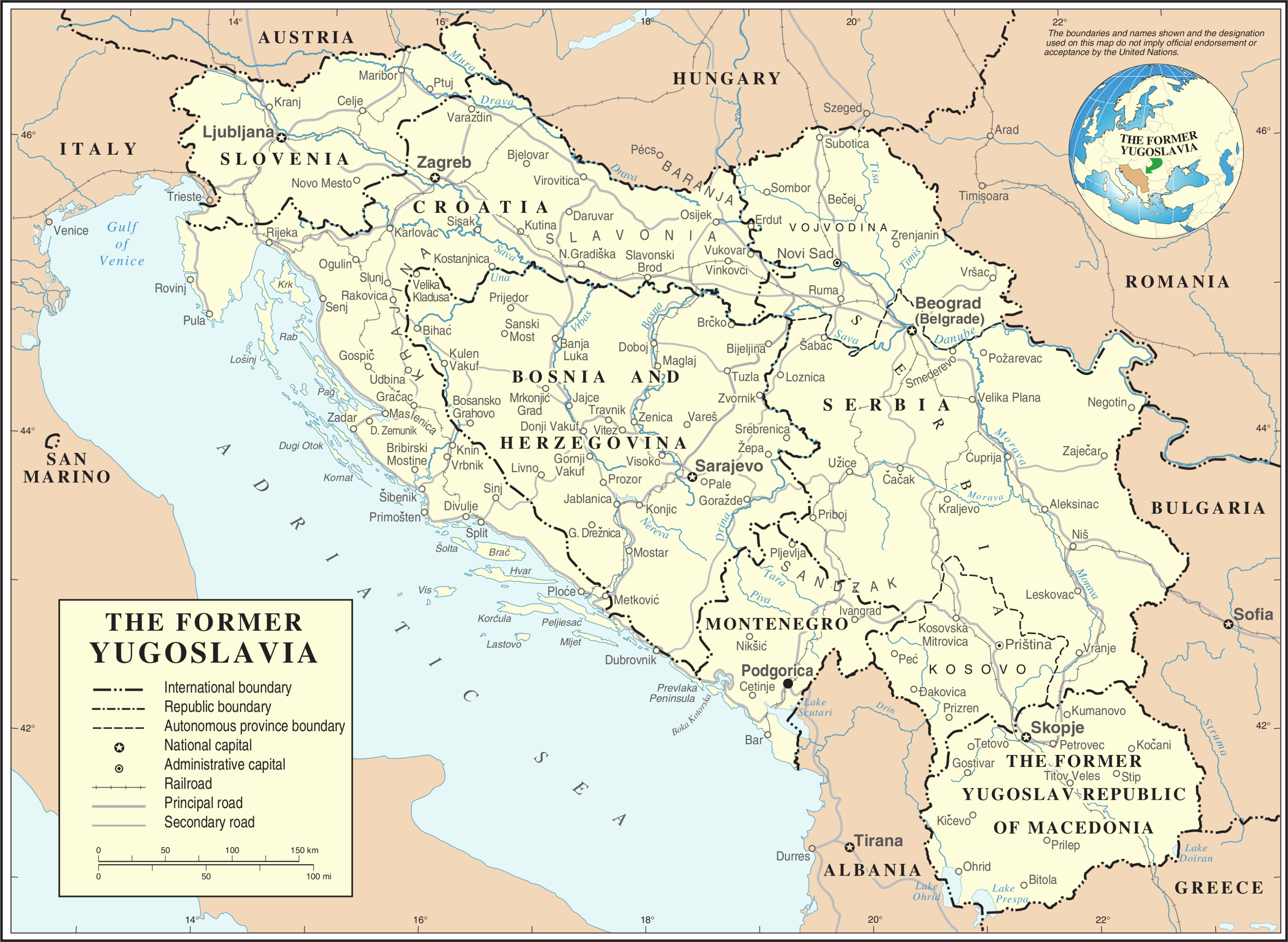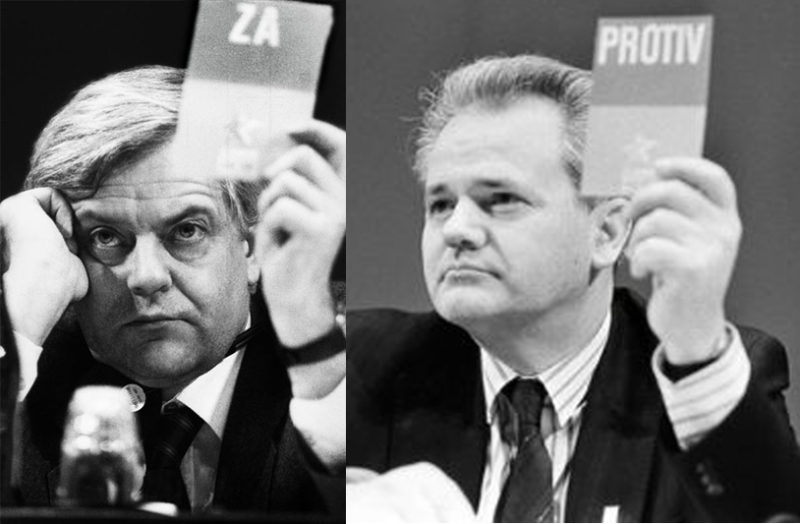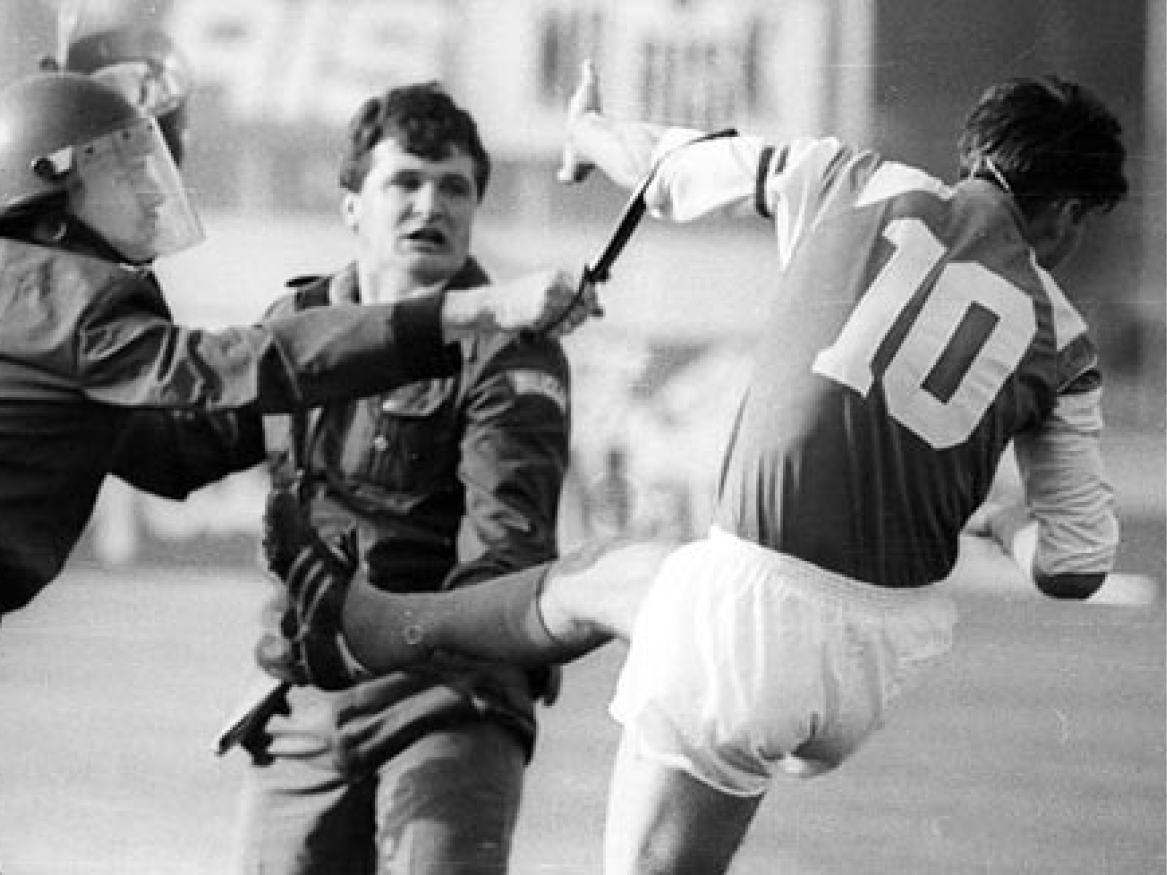Period:
Yugoslav Wars
Region:
Croatia
Destruction of Orthodox churches of th Metropolitanate of Zagreb and Ljubljana
Destruction, burning, devastation, and looting of Serbian Orthodox churches of the Metropolitanate of Zagreb and Ljubljana are criminal acts committed by the members of Croatian extremist groups, Croatian police, and paramilitary units, who were encouraged by friers of the Roman Catholic Church at the beginning of 1990s in the area of the Croatian Capital.
The series of these criminal acts are not coincidental but planned and systematically performed for a long period with the purpose of intimidation and ethnic cleansing of Serbs from the area of the city of Zagreb and surrounding, where more than 120,000 people of Serb nationality used to live.
From the very beginning of its rule, that is the spring of 1990, the militant Croatian party HDZ led by Franjo Tuđman were creating the atmosphere in which Serbs, JNA (Yugoslav Army), and SPC (Serbian Orthodox Church) were considered to be a disturbing factor that was supposed to be eliminated.
As early as the end of 1992, the Committee of SPC submitted a report to an authorized Yugoslavian, and later, international institutions about the damage that was made to its churches with detailed information about when and where the criminal acts happened.
Besides Zagreb, there were other places in Croatia where these acts were committed, and the crimes mentioned in the report do not represent an incident but just one segment of the joint criminal enterprise and the continuation of the genocidal policy from World War 2 by the clerical-fascistic regime of NDH (Independent State of Croatia) against Serbs.
BACKGROUND
SFR Yugoslavia was a federal state made up of 6 republics (FR Slovenia, FR Croatia, SR Bosnia, and Herzegovina, SR Montenegro, SR Serbia, and SR Macedonia). Both Yugoslavia and the JNA were established on the principle of “brotherhood and unity” of all peoples and nationalities who lived in the SFRY.
The social and economic system of the SFRY was socialism.
The 1974 Constitution of Yugoslavia brought about the decentralization of the SFRY, which later enabled the separatist forces in Slovenia and Croatia, and later in Bosnia and Herzegovina to begin the dissolution of Yugoslavia, followed by bloody wars and persecution.

In all the constitutions of Yugoslavia, the Yugoslav People's Army was defined as the only legitimate armed force in the territory of the SFRY, and therefore, the only internationally recognized military entity. At the end of 1989, the SFRY Assembly passed amendments to the Constitution, thus replacing the one-party system with the multiparty system, which meant that besides the Alliance of Communists of Yugoslavia, other parties could now be formed.
At the end of January 1990, the Alliance of Communists of Yugoslavia collapsed, at the 14th SKY Congress in Belgrade, when sharp verbal clashes between Slovenian and Serbian delegates occurred regarding the future of the joint state of the SFRY.

Opposing sides - Kučan and Milosević
The Slovenian delegation left the session, immediately followed by the delegation of the FR Croatia, which brought the issue of the congress into question. After them, the delegations of the FR of Bosnia and Herzegovina and the FR of Macedonia also left the congress.
Thus, after 45 years, the rule of the communists in SFRY ended.
The situation in FR Croatia
On the multi-party elections held in FR Croatia on 22 April 1990, the HDZ party won with its political program clearly stating the desire for independence and separation of FR Croatia from SFRY.

Collaborators against the Serbs: Tudjman and Račan
The victory sparked great euphoria throughout the Federal Republic of Croatia and displays of images of Ustasha criminals (Ante Pavelić, Alojzije Stepinac, Vjekoslav Luburić, and others), while Ustasha greetings and Ustasha songs could be frequently heard. This brought back memories of Serbs in SR Croatia of persecution and genocide in the Independent State of Croatia (The Nazi project between 1941-1945).
As early as spring, the HDZ and Franjo Tudjman took control of the police, the media, the prosecution and the state administration. Serbs working in the police were forced to leave in the spring of 1990 immediately after taking over the power, when the conflict at Maksimir (Zagreb's football stadium) between fans of NK Dinamo (Croatia) and FC Red Star (Serbia), were misused for anti-Serb propaganda.
Thus began a media war against everything that had to do with Serbia and Yugoslavia. In summer, the authorities of the FR Croatia in Zagreb made the decision to form the armed forces themselves. In October and November 1990, a large amount of weapons were illegally imported into the Federal Republic of Croatia for the needs of the reserve police forces, members of the HDZ and the VOC. The action was led by Martin Špegelj and Josip Boljkovac, ministers in the then government of Croatia.
Illegal arming of Croats
The JNA Counterintelligence Service made a film about this endeavor at the JNA military training polygon in Gakov in October 1990 and released it on TV Belgrade on 27 January 1991. On 22 December 1990, a "Christmas Constitution" was solemnly proclaimed in the Parliament, by which the Serbs lost their decades-old constitution rights and Croatia removed the name "socialist" in its name.
Since May 1990, the situation in FR Croatia started worsening day by day and the Serbs were terribly scared for their personal security and their property. Ustasha graffiti, slogans, posters could be seen regularly, and a large number of Serbs received threats by phone that they had to move out of their homes and go to SR Serbia. They even received threatening letters bearing the "HDZ" signature.

Violence in Zagreb at the Maksimir stadium
Even Croats who were married to Serbs received such threats.
Serbs in Croatia were fired from their jobs, and even their children were mentally and physically abused in schools. In almost all settlements where Croats had an absolute or relative majority, there were certain members of the HDZ party who had a task to keep an eye on the movement of their Serb neighbors (espionage).
THE LIST OF DEMOLISHED CHURCHES
(From the book Spirtiual Genocide by Slobodan Mileusnić)
Church of the Holy Archangels Michael and Gabriel built in 1795 (Bolč). “The Church of Archangels Michael and Gabriel in Bolč was dynamited and the entrance door set afire. Almost all the windows are shattered. We don’t know the time of bombing”- A report of 7 December 1992 (M No. 343/92).
Church of Saint Nicholas built in 1760 (Bolč)- Damaged by machine-gun fire.
Cathedral of the Holy Trinity - built in 1792 (Bjelovar), turned into Uniate church (1941-1945). “Holy Trinity Cathedral in Bjelovar, built in 1792 was devastated with some pillaging, a shell hitting the bell-tower. The Parish Home in Bjelovar was completely devastated”- A report from 7 December 1992 (M No. 343/92).
Cemetery Chapel (Bolč)- “The Chapel in the Graveyard in Bolč, the cross on the bell-tower leans to one side, most likely hit by gunfire.” “On 19/20 August 1991, an unidentified person placed explosives before the entrance doors to the Orthodox Church…” - A report of 7 December 1992.
Church of the 318 Holy God-bearing Fathers built in 1722 (Mala Trešnjica). Dynamited on 10 January 1992. Interior and roof destroyed.
Church of Saint Lazarus - built in 1713 (Velika Pisanica). Devasted and looted. Parish Home dynamited.
Church of the Holy Apostle Thomas- built in 1746 (Čađevac). Heavily damaged and impossible to use for Divine Services.
Church of Saint Demetrius- built around 1732 (Rastovac), and renovated in 1760. Set afire and destroyed.
Church of Saint Demetrius- built in 1760 (Mali Grđevac). Church burglarized, plundered, and devastated (1991-1993). Parish Home dynamited and set afire.
Church of the Holy Archdeacon Stephen- built in 1931 (Turčević Polje). Burglarized, looted, and devastated. Iconostasis destroyed. Holy Altar Table destroyed, most windows shattered. Roof leaks in several places.
Church of Saint Demetrius- built in 1768 (Stupovača). Dynamited and Parish Home looted.
Church of the Dormition of the Most Holy Theotokos (Donja Rašenica)- built in 1709. Set afire and destroyed, even though it carried the sign of the Hague Convention.
Metropolitan’s Residence- built 1886-1887 (Zagreb). Dynamited on 11 April 1992 at 10:45 p.m. outside war operations.
Church of Saint George- built in 1734 (Srpska Kapela). Damaged. Parish Home dynamited, only four walls remain.
Church of the Exaltation of the Honorable Cross (Veliki Zdenci)- built in 1744. In 1991-1992 the Croatian Ministry of Internal Affairs placed a machine-gun nest in bell-tower. Bell-tower no longer exists (1995). During 1996 Church razed and material removed. Parish Home dynamited.
Parish Home (Graberje; Ivanić-grad). “We found a fire burning in the exact center of the Parish Home. All the wooden floor, as well as all the doors, have already been removed.” A report of 7 December 1993.
Church of Saint John the Baptist- built in 1746 (Križ). Windows shattered.
Church of Saint Lazarus- built in 1758 (Plavšinci). Windows broken.
Church of the Holy Apostles Peter and Paul- built in 1770 (Severin). Damaged.
Church of Saint George- built in 1760 (Glogovac). “Saint George’s Church in Glogovac from 1760, main entrance door into the Church set afire, on 9 May 1991 according to locals and the police.” A report of 7 December 1992.
Church of the Nativity of the Most Holy Theotokos- built in 1740 (Kupinovac). Bell-tower damaged, doors set afire. Church in poor condition.
Church of Saint Mark- renovated in 1950 and 1985 (Velika Barna). Damaged during war operations.
Church of Saint George- built in 1884 (Varaždin). Church damaged, windows shattered by the detonation, and decorative column at the entrance side blown out.
Church of Saint Petka- built in 1895 (Sisak). Bell-tower damaged, two columns broken. Parish Home and chapel burglarized and dynamited, windows shattered.
Church of the Transfiguration of the Lord- built in 1794 (Zagreb). Church damaged before any war operations: burglarized during the night between 27 and 28 January 1991; damaged several times afterwards.
Church of Saint Sava- built in 1902 (Križevci). Windows on church broken. Gutters ruined.
Diocesan Museum in the Metropolitan’s Residence (Zagreb). Dynamited with dozens of kilograms of explosives, blowing up church art treasures and other historical items witnessing Serbian spiritual, cultural, and creative talent from the former Diocese of Marča founded in the 16th century.
Church of the Holy Archangel Michael- built in 1740 (Velika Mučna). Dynamited on 24 and 25 December 1992 outside of war operations.
Church of Saint Petka- built in 1895 (Velika Peratovica) on the foundations of an older wooden church from 1790. Devastated, iconostasis destroyed and all windows shattered.
Church of Saint Vitus- built in 1752 (Grabovnica near Čazma). Heavily damaged. Bell-tower without roofing, windows shattered, and roof damaged.
Monastery Marča- Chapel of the Holy Archangel Gabriel from 1925 (Čazma). Dynamited (Report No. 34/97).
Church of the 318 Holy God-bearing Fathers- built in 1927 (Javorovac). Damaged.
Church of Saint George- built in 1770 (Narta). Damaged by machine-gun fire. Parish Home burglarized and damaged.
Church of the Holy Archangel Michael- built in 1936 (Sibenik). Burglarized, plundered, and devastated.
Church of Saint Petka- built in 1570 (Salnik). Church dynamited on 19/20 December 1992. The greatest damage to the exterior in numerous places.
Church of the Dormition of the Most Holy Theotokos- built in 1722 (Srijedska). Damaged by machine-gun and hand-gun fire.
Church of the Holy Trinity- built in 1752 (Veliki Grđevac). Graffiti written on the church: “ISC” (Independent State of Croatia) and “Death to the Serbs”.
EXPELLED PRIESTS OF SERBIAN ORTHODOX CHURCH
Not only Orthodox Churches and property have been demolished, but parish priests have been expelled as well.
In Zagreb- bishops Mlađen Jović, Vajo Jović, Radovan Majstorović, Nedeljko Božić, and heiromonk Nikolaj Marunić;
In Grubišno Polje- archpriests Marinko Juretić, and Miroslav Nedeljković, bishops Nenad Obradović, and Dimitrije Šljokić, protonamesnik Dušan Kalinić;
In Bjelovar- archpriest Dušan Stefanović, bishop Kristo Aleksić, Milenko Jekić, and Dragan Đuričić, hieromonk Jakov Radojčić, and Mihailo Kalanj;
ORGANISERS AND EXECUTORS
The destruction could have hardly been an act of a minor group of hooligans or even armed terrorists, especially if they didn’t have powerful explosives for that level of damage.
According to the testimonies of parish priests and parishioners, those were the members of Croatian military forces, police units, and the so-called Croatian National Guard that were involved in the destruction and burning of the property of Serbian churches and monasteries of the Metropolitanate of Zagreb and Ljubljana from 1991 through 1992. Demolition and plundering were left to Croatian extremists gathered around the militant party- Croatian Democratic Community led by Franjo Tuđman.

Retribution expedition: Masni Krati
The evil they committed was encouraged and incited by all ranks in the hierarchy of the Roman-Catholic Church in Croatia, who had unfounded suspicion and fear of orthodox “schismatics” that lived in these areas with them. This was seen as a way to expel orthodox Serbs, and seize or destroy their property. A small number of Catholic priests refused to participate in such immoral activities.
Similar crimes were committed by Croatian Ustashas and Catholic friers during World War 2 on the whole area of clerical-fascistic ISC( Independent State of Croatia) which included the territory of the diocese of Zagreb and Ljubljana. Their ideology of Serbophobia endured in Croatia during the 1990s.
AFTERMATH
The Metropolitanate of Zagreb-Ljubljana formed a delegation in late November of 1992 that inspected areas where the destruction took place and made a report which was made official on 7 December. The delegation inspected in the presence of police forces because their safety was in danger.

Tadeusz Mazowiecki- "If it is not recorded, it didn't happen".
The report was later sent to the Holy Synod of the Serbian Orthodox Church, and the Yugoslav Committee for the Collection of Data on Crimes Committed against Humanity and International Law that was established based on Resolution no. 780 of the Security Council of the UN.
The creation of the report was suggested by Tadeusz Mazowiecki, a UN Special Rapporteur of the Commission on Human Rights.
The written data suggest that around 50 churches were destroyed, demolished, and burned down in the area of the Metropolitanate of Zagreb-Ljubljana, while in the territory of the Republic of Croatia, the number is far greater than this, with more than 200 churches and parish homes destroyed.
YEARS LATER
Although the Civil War in Croatia ended in 1995 with the expulsion of 250,000 Serbs from the areas of North Dalmatia, Lika, Banija, and Kordun during the criminal operation “Storm”. A small number of refugees returned to their lands after reaching the Erdut Agreement by which the Republic of Croatia reoccupied Srem and Baranja. The reasons were mostly due to insecurity because returnees faced verbal and physical attacks, property plunder, and similar. Also, they had problems with the legal system that was created to make their return impossible and to find a job because of their nationality and religious status.
After 2000, the EU requested Croatia to renew houses and religious facilities at its territory. However, they deliberately avoided fulfilling these requests because they feared that Serbs could return in greater number if their homes were renewed.
PUBLICATIONS
A documentary was not made regarding the 90s destruction of churches, graveyards, cultural and historical monuments in the territory of the metropolitanate of Zagreb-Ljubljana.
There is only one book about these crimes- “Spiritual Genocide” written by Slobodan Mileusnić with the blessing of the Serbian Patriarch Pavle and published with the help of the Museum of the Serbian Orthodox Church. The book is bilingual, written in Serbian and English languages.

Not any public discussion has been organized in the territory of ex-Yugoslavia regarding these crimes.
CONCLUSION
The destruction of SPC property in the territory of the Metropolitanate of Zagreb-Ljubljana was planned and organized by the highest state representatives, including the Army and Police forces. It was clear that all destroyed and demolished facilities were out of war zones.
This was, in fact, the part of JOINT CRIMINAL ENTERPRISE which involved representatives of Roman Catholic Chruch in Croatia. This means that the crime involved joint efforts of the state administration, military forces, and church.
The aim was to expel orthodox Serbs and take their property. What was left undone in 1914 (WW1) and 1941 (WW2), was completed at the end of the 20th century.
Today, the Republic of Croatia is the ethnically cleanest state in Europe.
Tags:
Please, vote for this article:
Visited: 4853 point
Number of votes: 11
|